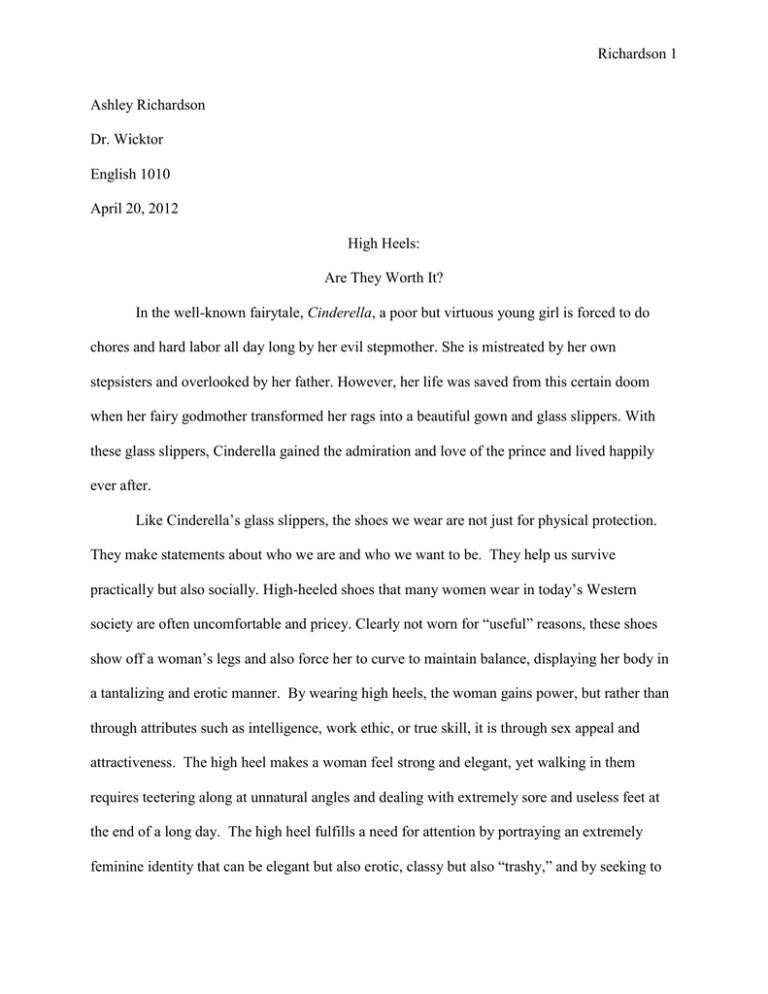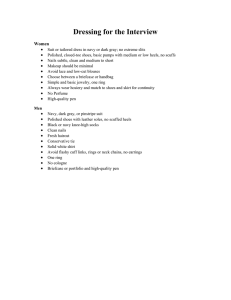
Richardson 1
Ashley Richardson
Dr. Wicktor
English 1010
April 20, 2012
High Heels:
Are They Worth It?
In the well-known fairytale, Cinderella, a poor but virtuous young girl is forced to do
chores and hard labor all day long by her evil stepmother. She is mistreated by her own
stepsisters and overlooked by her father. However, her life was saved from this certain doom
when her fairy godmother transformed her rags into a beautiful gown and glass slippers. With
these glass slippers, Cinderella gained the admiration and love of the prince and lived happily
ever after.
Like Cinderella’s glass slippers, the shoes we wear are not just for physical protection.
They make statements about who we are and who we want to be. They help us survive
practically but also socially. High-heeled shoes that many women wear in today’s Western
society are often uncomfortable and pricey. Clearly not worn for “useful” reasons, these shoes
show off a woman’s legs and also force her to curve to maintain balance, displaying her body in
a tantalizing and erotic manner. By wearing high heels, the woman gains power, but rather than
through attributes such as intelligence, work ethic, or true skill, it is through sex appeal and
attractiveness. The high heel makes a woman feel strong and elegant, yet walking in them
requires teetering along at unnatural angles and dealing with extremely sore and useless feet at
the end of a long day. The high heel fulfills a need for attention by portraying an extremely
feminine identity that can be elegant but also erotic, classy but also “trashy,” and by seeking to
Richardson 2
gain power through showing off her body, she loses any real chance for self-empowerment she
might have had otherwise. In contrast to a flat heel, a high heel creates an illusion of luxury,
power, and femininity that actually takes power away from women by emphasizing the need
some women feel to “measure up” to others by making her taller, slimmer, and sexier.
In his book “Of Cigarettes, High Heels, and Other Interesting Things,” Marcel Danesi
explains the emergence of the high heel. High heeled shoes first appeared in fourteenth century
Venice and were worn by aristocratic women who wanted to set themselves apart from lowly
peasants. (12) In sixteenth century England, high heels were a sign of wealth, style, and status
and were worn by both men and women. In the article “Footprints of History,” Giorgio Riello
and Peter McNeil introduce the first type of heeled footwear, called the pianella. The pianella
was characterized by thick soles up to twenty inches high and were a popular way to keep men’s
robes and ladies’ gowns from touching the dirty streets of medieval Europe (31). The high heel
was classy, but also restricting to the wearer because of its unstableness. Towards the end of the
seventeenth century, differences in men’s and women’s shoes became increasingly evident with
men’s shoes becoming heavier and sturdier and women’s becoming thinner and more delicate.
These shoes prevented women from engaging in physical labor. The lack of mobility was
desirable, implying that the wearer was wealthy and could pay someone else to do the menial
labor. Riello and McNeil say that by the eighteenth century, high heeled shoes were considered
to be exclusively women’s footwear, and heels became so high that women had to use walking
sticks. (227) Women were literally handicapping themselves and choosing to become dependent
and powerless.
High heels were considered “scandalous” in the mid-seventeenth century, because of
their sexual implications. In the magazine article “High Heels, the Agony, the Ecstasy,” William
Richardson 3
Rossi states that high heels first gained popularity with the American public through brothels.
Madam Kathy, a brothel owner, recorded that she “could double the charges when the girls
sashayed around in those high heels. It gave them a look of class.” (29) High heels gained a
reputation as dirty and were associated with unfaithful women who had sexual power over men.
High heels still have, as Rossi puts it, “provocative power” today (Rossi, 28). Many fashion
magazines, ads, movies, celebrities, and models show just how prominent and important heels
are in today’s society. Business women, Playboy models, and high school girls going to prom
are often expected to wear some sort of high heel. High heels are exaggerators. They demand
attention. The unnatural arch presents the foot as smaller than its actual size, flexes and slims the
leg, and makes a woman appear taller and sexier. High heels make women appear more
“feminine,” but in reality, the unnatural posture and awkward, small steps deny a woman’s
natural femininity and shut out the real power they have as human beings.
High heels may make a women feel powerful, confident, and sexy, but in conforming to
the desires of others, women oppose all of that. Women give the power, maybe just
subconsciously, to whomever they are wearing the heels for. Rossi shows this when he shares a
Marilyn Monroe quote: “I don’t know who invented high heels, fellas, but women owe him a
lot” (31). Marilyn gives credit for the invention of the high heel to a man without any knowledge
of who actually created it. She is assuming men have more intelligence, insight, and creativeness
than women by assuming the inventor is a “him.” This topic is dealt with further in Elizabeth
Semmelhack’s chapter of the anthology Shoes called “A Delicate Balance,” where she says that
the high heel “reflect[s] established male fantasies rather than sexual liberation or equality” (237)
Alexandra Howson introduces another interesting idea in her book The Body in Society that
allow us to conclude that even high heels seem to display strength and independence, a woman
Richardson 4
in high heels is actually reinforcing a need for acceptance from men by adopting “‘male values’
of ‘ideal’ female bodily form” and attempting to embody them (105). These shoes give the
impression that their bodies (and heels) can be used to seduce men and overcome them by
exploiting their sexual desires, but to do this, the women must first abandon their own femininity
and taste and go after an unattainable “‘ideal’ female form” to be accepted.
In Neil Philip’s book The Cinderella Story, he used a version of the Cinderella story
called “Askenbasken, who Became Queen.” In this version, Cinderella’s two stepsisters aspire to
become the king’s wife, which determines their successfulness and worth. Just like in the
contemporary version, the king goes around with a precious slipper to find his perfect princess.
Looking for the owner of the slipper, the kind arrives at the stepmother’s house, and the story
continues:
But the eldest could not get it on, for her great toe was too long. Her old mother
whispered in her ear, ‘Cut if off! Better to lose a toe than lose a chance of being
queen!’ So she went in and took a great knife from the table and cut off her toe.
Now she could get the shoe on, and so she was able to go home with the king.
(55)
A small while later, the blood dripping out of the shoe gives her away and she is returned
to her modest home with no money, jewels, or king. A similar situation occurs with the
other stepsister, except that her heel is too wide. This girl is also caught in her lie by the
blood coming out of the shoe, and she does not marry the king either. Finally,
Askenbasken appears and her tiny foot fits flawlessly into the tiny slipper. The story
ends with: “And ever after the king lived happily with the girl who had been called
Askenbasken, but now had to be called queen; for now she was in her rightful place”
Richardson 5
(57). The girl was in her “rightful” place, living a life of much luxury. This sends the
message that power for women comes through men and the approval of men. Instead of
building their own successful lives, the two women felt the need to mutilate themselves
to gain acceptance. The message is that these women had no value without a man. With
this story, high heeled shoes are again connected with luxury and femininity, and it is
suggested that women not in high heels do not measure up.
The connection between shoes and a luxurious life is not limited to the “Cinderella”
stories. Riello and McNeil explain, “A woman incapable of moving freely was a sign of her
husband’s status and wealth. She was a spouse with no manual responsibilities” (32). The
premodern Chinese culture’s practice of foot binding also embodies this idea. In his chapter
“Shoes in Chinese Culture” in the work Shoes, Paola Zamperini tells about foot binding. A
woman subjects herself to the long, painful process of wrapping her feet to make them smaller
and smaller until the ultimately perfect foot is created. Foot bones are broken, and her feet reach
a size so small that she becomes completely immobile (197). The end result is considered
beautiful, but the woman is being used as an object and a show. Similar to foot binding, high
heels do not represent a women’s success, independence, or power. It indicates a luxurious life
for the woman but one that makes her completely dependent on others for survival. High heels
make the wearer vulnerable, but not in a positive, honest way. Instead this vulnerability is an
attempt to cling to another’s success. These women are being used to elevate a man’s reputation
as a successful provider.
Although high heels were directly linked to luxury in the past, today they are directly
linked with body image. High heels have decided for us that a taller, slimmer, but still slightly
curvy woman is sexiest. The way we perceive our own bodies determines what we buy.
Richardson 6
Therefore clothing is not purchased for its “use” value but because of its desirability and the kind
of statements it makes about the consumer. Again, Howson provides information about gender
and identity: “Women are…subtly coerced to embody beauty and men are encouraged to desire
and possess beautiful women” (95). In the pursuit of beauty and desirability, women carefully
select the shoes they believe will make them attractive. Often these shoes are high heels. Perhaps
that is because, as Riello and McNeil state, high heels have “created specific social and cultural
constructions of femininity, from the pinup to the ‘girl power’ of the 1990s” (25). High heels are
purchased in hopes of attaining this culturally valued femininity.
Along with providing a false sense of emotional health, wearing high heels can have
adverse effects on women’s physical health as well, slowing down and even immobilizing the
wearer. After a long day of wearing heels, feet are squeezed, blistered, tired, and swollen. In the
medical journal, Lancet, from 1877, the scientists stated their awareness and concern over the
negative health effect of wearing high heels. It says, “The effect of the oblique position of the
foot is, of course, to remove the weight of the body from its natural support [and cause] an acute
pain in the sole of the foot [and] considerable tenderness” (78). Heeled shoes also cause
women’s walks to be different than when in flat shoes. The Lancet reports, “The toes, instead of
the heel, first touch the ground, and the walk is clumsy and heavy…The toes become
permanently fixed and pressed together, partly in consequence of the narrowness of the front part
of the boot, partly in consequences of the overaction of the flexors of the toes” (78). As far back
as the nineteenth century, medical experts were concerned about the damage caused by high
heels, but the high heel continued to thrive. Heeled shoes have always caused a walk that is
choppy, unnatural, and harmful to a woman’s feet and overall health. In her blog “High Heels.
Pelvic Floor, and Bad Science,” Katy Bowman, a biomechanist, disproves research that high
Richardson 7
heels cause the pelvic floor to strengthen by stating that “… a neutral pelvis will give you
optimal pelvic strength.” High heels cause the foot to tilt forward, which causes the pelvis to tilt
forward, which causes the wearer to stand in a way that weakens the pelvic floor. Contrary to
the illusion of strength that high heels try to provide, scientific facts prove that high heels
actually weaken the body. Power is not given to one who wears high heels, but it is taken away,
both short term through partially immobilizing the wearer (try running away from an attacker in
stilettos!), and long term through gradual weakening of different parts of the body.
Despite these discomforts, high heels continue to be a prominent fixture in our everyday
lives. Women in our culture are drawn to high heels of all different shapes, heel lengths and
widths, and colors. There are endless ways that high heels can make a women feel special. In his
magazine article, Rossi includes a poem written in the 1930’s by a woman named Jennie Farley.
She writes:
I hate those heels on the hoof, on the street
They make you suffer though each looks sweet.
I’ll not be beguiled, despite their appeals.
As of today, I’m swearing off heels.
Unless, of course, a Don Juan comes by
Who likes me with heels impossibly high.
Then back to stilts, though the shoe abuses,
Life’s short.
Love’s long—and worth a few bruises.
(31)
Richardson 8
This poem captures the essence of the high heel dilemma. This ditty recognizes the pain and
ridiculousness of wearing high heels, but reveals the struggle between knowing logically what
makes sense and still feeling the need to be desirable by our society’s standards. Farley’s
opinion is that getting her “Don Juan” is “worth a few bruises,” but by saying this, she implies
that the man will not “like” her without the heels. This not only holds the woman to an
impossibly high standard to be desirable and attractive enough, but also defines the man as a
shallow, self-indulgent being without even considering otherwise. In Farley’s poem, she tells us
how high heels make her feel like a woman who is worthy enough for the intentions of a
handsome lover. In reality, she is the same woman with or without her “stilts.”
In a business world with so many heels clicking up steps and into offices, women who
decide not to wear heels may put themselves at odds in the work place. Women in flats may
seem less professional than those with higher heels, even though the history of the high heel
takes us through brothels and places where women were not exactly at the top of the “corporate
ladder.” Men’s and women’s business attire is similar, with dark suits and jackets, but women
often have tighter, bustier, and overall more revealing clothing than men. Women’s shoes are no
exception. Many business women use their attractiveness to prove their intelligence. One way of
gaining power is by wearing high heels. Riello and Giorgio state that in the past, wearing a flat
heel was perceived as an “unmistakable sign of inferior social position” (25), and flat heels are
still perceived that way today. Women’s competence is much more often based on appearance,
even in positions of high authority, and the presence of the high heel proves it.
Today women walk around in red pumps, black stilettos, peep toe heels, wedges, and
strappy heels. It is common, so our society does not realize the full effect of how high heels
change the way we think about our personal identity and roles of men and women. Historically,
Richardson 9
high heels have signified different beliefs in different cultures, but emotions generated by
wearing high heels have remained the same. High heels have always given women the illusion
of luxury and power, but in the end, it is only an illusion.
Richardson 10
Works Cited
Bowman, Katy. “High Heels, Pelvic Floor, and Bad Science.” Katy’s Blog. N.p., 29 Aug. 2011.
Web. 5 April 2012.
Danesi, Marcel. Of Cigarettes, High Heels, and Other Interesting Things. New York: Palgrave
Macmillan, 2008. Print.
Howson, Alexandra. “The Body in Consumer Culture.” The Body in Society. Malden:
Blackwell Publishing Inc., 2004. 93-119. Print.
Lancet. “High Heels.” Medical News. (1877): 78. Print.
Philip, Neil. The Cinderella Story: The Origins and Variations of the Story known as
“Cinderella.” New York: Penguin Books, 1989. Print.
Riello, Giorgio and Peter McNeil, eds. Shoes: A History from Sandals to Sneakers. New York:
Berg, 2006. Print.
Riello, Giorgio, and Peter McNeil. “Footprints of History.” History Today 57.3 (2007): 30-36.
Print.
Rossi, William. “High Heels, the Agony & the Ecstasy.” Footwear News Magazine Nov. 1985:
28-31. Business & Company Resource Center. Web. 25 March 2012.
Semmelhack, Elizabeth. “A Delicate Balance: Women, Power and High Heels.” Shoes: A
History from Sandals to Sneakers. Eds. Giorgio Riello and Peter McNeil. New York:
Berg, 2006. 224-249. Print.
Zamperini, Paola. “Shoes in Chinese Culture.” Shoes: A History from Sandals to Sneakers.
Eds. Giorgio Riello and Peter McNeil. New York: Berg, 2006. 196-204. Print.






